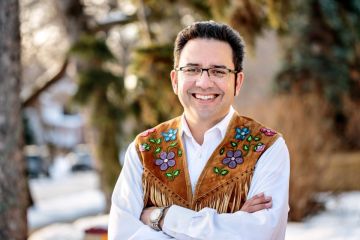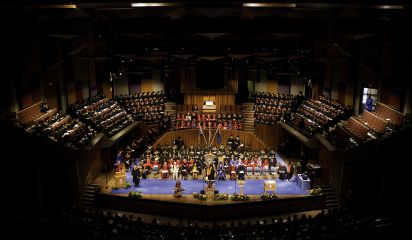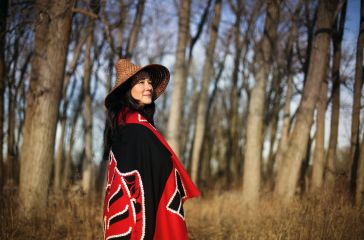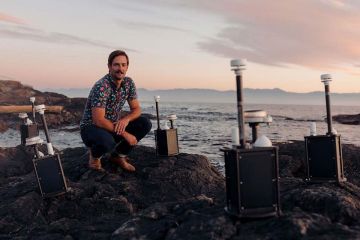Space to Grow
- Michael Kissinger

Astrophysicist Julie Claveau, BSc ’09, has taken a fascinating career trajectory to her current work on the James Webb Telescope, which will reveal new secrets of the universe.
For someone who’s spent most her life gazing up at the stars, Julie Claveau is very down to earth. Take a quick orbit around the UVic Science grad’s social media universe and you’ll discover Claveau is not only a Program Scientist for the Canadian Space Agency (CSA) who’s been working on the newly launched James Webb Space Telescope, but a mother of three, a blogger, a YouTuber, an avid World of Warcraft gamer, violinist, dancer and former lifeguard. Her Instagram feed straddles the seemingly distant galaxies of astronomy, family, gardening and baking.
“People often have these stereotypes that if you’re an astrophysicist you’re this kind of person… But there are so many different facets of a person that adds to what they have to offer to the world, or a team,” Claveau says on a Zoom call from her home in Montreal while intermittently getting interrupted by one of her school-aged children. “I really want to give back to the world just so people can learn from what I know.”
The trajectory of Claveau’s journey to working with the international space community on a $10-billion telescope that’s been billed as one of the most ambitious engineering initiatives ever attempted is far from a straight line. There are stops along the way in Australia, Kitimat and Victoria. Her job experience includes everything from working in fast-food drive-thrus to a decade of climbing the rungs of federal bureaucracy.
Claveau became enthralled by outer space as a child when she would lie on the lawn, night or day, and stare up at the sky. “I would lie there for hours trying to imagine how far infinity was. Like, ‘Oh, I’m looking this far… but it keeps going and it keeps going,’” she says. “It was a very mind-blowing concept to wrap my young brain around, that I still can’t wrap my head around today.”
Claveau grew up in Chicoutimi, Quebec, lived in Australia with her family for a time (where she became fluent in English) and graduated from high school in Kitimat, before enrolling at UVic as a science student. She eventually narrowed her focus to physics and astronomy.
“That’s where all of my loves are. There was enough challenging problem-solving to satisfy my thirst. There was enough creativity and freedom in order for me to express myself. So that really was the turning point.… When I found physics and astronomy [at UVic], it was so true to my heart, it was so engrained in my soul, it just made me so inherently happy that I knew I found my place.”
Julio Navarro was Claveau’s astronomy professor.
There are those students who are very proactive, and they are always trying to get to know more. [Claveau] was very intense, as well. She would come to my office hours and ask me questions, so she was very passionate about astronomy. I think that’s one of the things that separates her from an average student—this passion for astronomy that you only see rarely."
—Julio Navarro, UVic cosmologist
While attending UVic, Claveau subsidized her studies by working as a naval reservist at HMCS Malahat. Her father had been in the military and she was an air cadet in high school, so it was a natural fit. After graduating from UVic in 2009, Claveau returned to Quebec, feeling aimless and unsure of what to do with her physics degree.
After a few years working for Health Canada, Claveau realized she needed a change. She saw there was an opening at the Canada Space Agency for a mission planner for the RADARSAT-2 Earth observation satellite. Her background in physics, military operations, administration and project management ticked all the boxes.
Once at CSA, Claveau made it known that she was an astrophysicist and wanted to work in astronomy. Colleagues noted her passion and drive. Word got around and two years ago, she became Program Scientist for Space Astronomy, acting as a conduit between Canada and other countries, governments, space agencies, industries and universities. Her primary focus, however, has been the James Webb Space Telescope mission. More than 25 years and $10 billion in the making, the Webb Telescope is a collaboration between NASA, CSA and the European Space Agency (ESA), involving more than 1,000 people from 17 different countries.

Webb is often described as the successor to the Hubble Space Telescope, which launched in 1990 and has well exceeded its 10-year life expectancy, but it’s different, says Claveau. For one thing, it’s bigger. Webb’s primary mirror is 6.5-metres across, compared to Hubble’s 2.4-metre span, and consists of 18 gold–coated hexagonal sections resembling a honeycomb.
Webb’s home is also considerably farther away. Whereas Hubble floats 547 kilometres above Earth, Webb orbits the sun in line with Earth, 1.5 million kilometres away at what is called the second Lagrange point or L2. From this orbit, it places Webb in perfect alignment with the Earth and Sun. This allows its tennis court-sized sunshield, which had to be folded up in its launch rocket along with the mirrors, to protect the science instruments from nearby radiation.
Unlike Hubble, Webb is designed to capture infrared light, allowing the telescope to see farther into the universe than ever before, which will allow scientists to better understand how planets, stars and galaxies are born and evolve over time. Claveau compares Webb to a time machine.
“We will be able to see about 13.5 billion years ago, because light takes time to travel,” Claveau says. “The light of our sun takes about eight minutes to get to us… So, when you look at the sun, you are actually looking eight minutes into the past."
When we use Webb to look at this far distant light, we’ll be looking back at the beginning of the universe. Just being able to see that will have tremendous impacts on every single field of astronomy possible. We might discover things that we never thought existed... It’s going to completely revolutionize astronomy and our general understanding of the universe."
—Julie Claveau, UVic Class '09
Canada’s contribution to Webb is also significant. The CSA provided the telescope’s Fine Guidance Sensor (FGS) and the Near-Infrared Imager and Slitless Spectrograph (NIRISS). The FGS helps Webb point and focus on specific objects with an accuracy Claveau compares to “seeing a baby’s hair from a kilometre away.” The NIRISS contains a highly sensitive camera that will determine the atmospheric compositions of exoplanets, which are planets light years beyond our solar system that orbit stars other than the sun.
“So far, we’ve been able to identify exoplanets… but we don’t know if they are inhabitable or if there could potentially be life there,” Claveau says. “With Webb, we will be able to know the composition of the atmospheres of those exoplanets, which means we will potentially find new life or habitable planets.”
Although Webb was launched into orbit on Christmas Day in 2021 from French Guiana on an ESA Ariane 5 rocket, it will take approximately five to six months before the first official images are produced and transmitted back to Earth. Thanks to Canada’s contributions, Canadian scientists are guaranteed at least five per cent of Webb’s observation time and will be among the first to benefit from Webb’s powerful instruments.
Claveau is also co-chair of the Women in STEM Advisory Committee at the Canadian Space Agency, and is helping organize a 2023 event with the United Nations Office for Outer Space Affairs (UNOOSA) to promote women’s empowerment in space.
Never stop looking up—I think it was Stephen Hawkings who said that. As humans we are always looking down at our feet or we’re focused on our day-to-day existence. But the moment you start looking up, you have an out-of-body experience where you feel so small and immediately you are in wonder. Be curious, look up and dare to dream."
—Claveau
Photos
In this story
Keywords: alumni, space, technology, partnerships, research, administrative, physics, astronomy
People: Julie Claveau, Julio Navarro
Publication: The Torch






